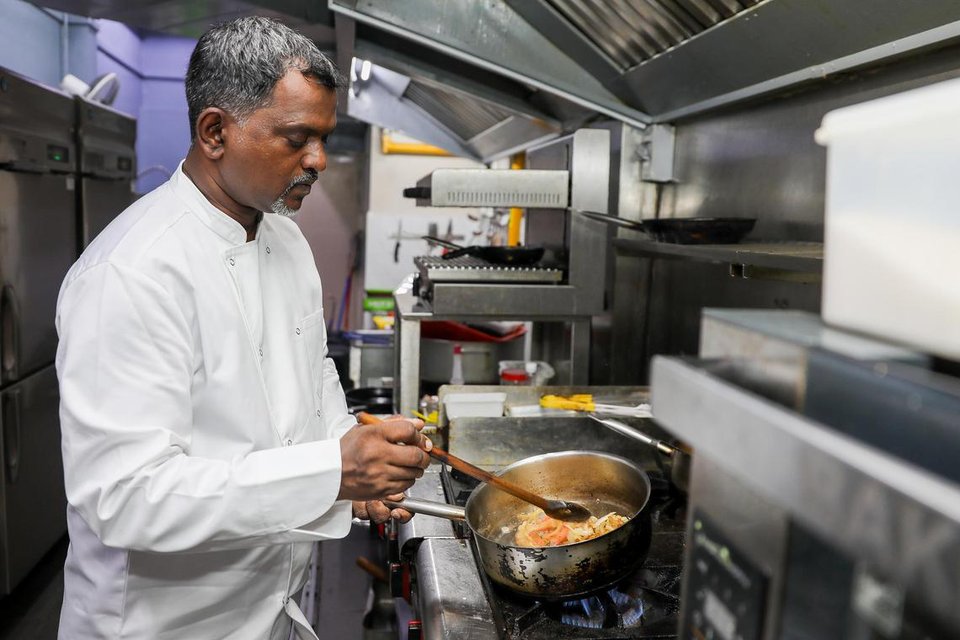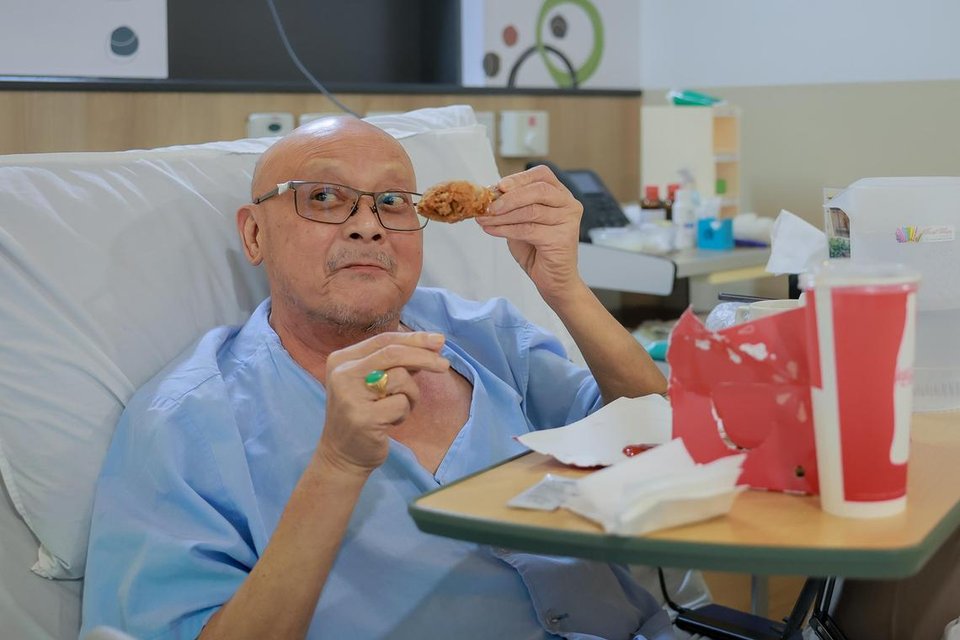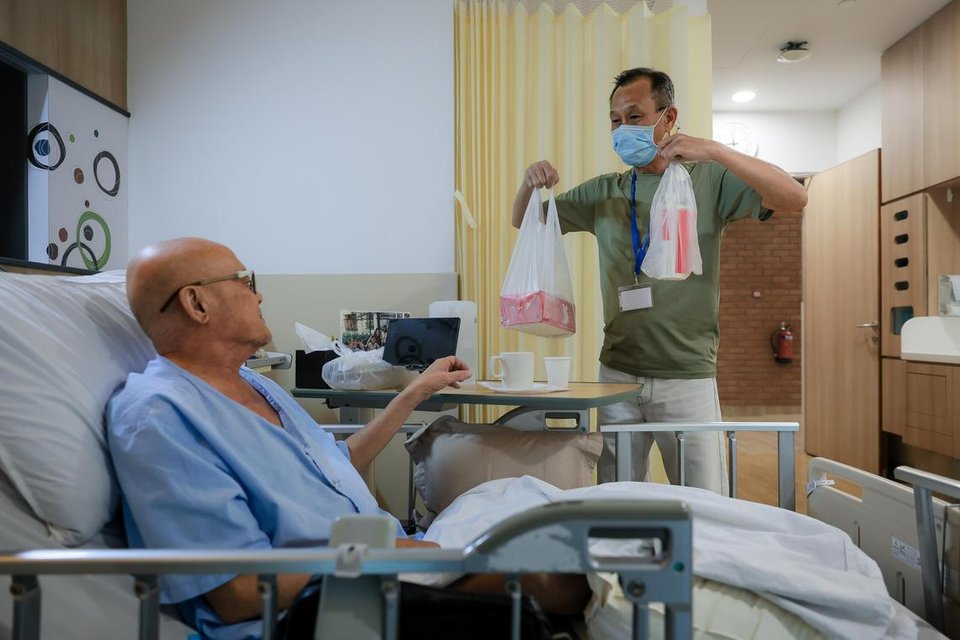August 11, 2025
SINGAPORE – In nearly four decades in the kitchen, chef Rathakrishnan Ramaiyan has received all sorts of requests. Less sugar, more relish, no dairy, softer fish. For the most part, nothing too out of the ordinary.
Perhaps the most memorable came in November 2017, when a priest’s aide stepped through the doors of The Black Sheep Cafe, a French restaurant then located in a quiet corner off Upper Thomson Road, and ordered a bowl of French onion soup with super soft onions.
Super soft because the soup was intended for the bedside of Father Louis Loiseau, a 91-year-old priest whose life had begun in France and was ending in Singapore. Craving something familiar, the ailing priest had asked specifically for chef Ratha’s onion soup.

Chef Rathakrishnan Ramaiyan once cooked for a dying priest, who wanted a French onion soup with extra soft onions. PHOTO: THE STRAITS TIMES
And so, a routine was established. Over the next two months, his aides dropped by the restaurant twice a week to pick up the special order. When their messages stopped in January 2018, chef Ratha knew that his customer had died.
Cooking for the dying is an act fraught with emotion for the 56-year-old chef, whose restaurant has since moved to Norris Road. While being able to supply Father Loiseau with a final taste of home was a bittersweet honour – “I don’t care for a Michelin star. This was my Michelin star,” he says – his unexpected role as a sort of culinary death doula has, at times, taken a toll.
“It’s quite hard to have someone walk into your restaurant and announce that they’re going to die,” he says, having encountered several such instances over the years. It is his restaurant regulars flock to after a bad diagnosis, his beef cheek, duck confit and red wine which they savour as a last indulgence.
But he is certain that his calling is to feed people and extend hospitality however and whenever required. Whether in times of sorrow or joy, celebration or contemplation.
“We celebrate and console one another with food, it is a token of love and concern, especially in very food-centric cultures such as what we have in Asia,” says Dr Paul Victor Patinadan, an assistant professor at Nanyang Technological University’s School of Social Sciences, who studies end-of-life care. “All these thoughts, feelings, values, beliefs, traditions and memories coalesce in the simple medium of what we eat and how we prepare it.”
Because food is such an evocative medium, it makes for a compelling metaphorical full stop at the end of one’s story. This idea that a lifetime of experiences and preferences can be distilled into a few dishes, in part, explains the morbid fascination with the last meals of death row inmates.
What about those meeting a more peaceful end, with no firm expiry date – what do they crave at the end of life? Here is how food breaks up the monotony of twilight, cushioning the end with fluffy buns, creamy durians and the effervescence of a familiar can of beer.
One last party
It is the second last Thursday of July and Madam Mary Ho has just about had it with plain porridge. All week long, the 83-year-old has been living off bland meals that excite neither her taste buds nor her stomach.
“Usually, I have a pretty good appetite, but this week, I was told that I have to restrain myself,” she grouses.
Nonetheless, she has obediently complied – “I’ve been so good!” – spurred by the thought of Saturday. Saturday, her daughter Elisa Soon tells her, is the goal, for that is when the entire extended family, all her nine siblings and four children, will reunite at St Andrew’s Community Hospital (SACH), where Madam Ho, who has endometrial cancer, is staying.
Though the widow, whose husband died in 2011, is used to being alone, nothing makes her day like a bowl of fish soup bought by her daughter, or her sister’s homemade bird’s nest soup – thick, slippery spoonfuls of jelly, so unlike the “watery, overpriced” slop sold in stores.
Heartburn has made eating difficult lately, but she hopes the cleanse will help her enjoy the feast her family is preparing. On the menu is chilli crab, popiah, fried hokkien mee, roast pork and other dishes summing up a lifetime’s love of food and cooking.
“I don’t know how many years it’s been since we had everyone together like this. We’re happy we have the chance to do this while she’s still alive. Not all families get the chance to say a proper goodbye,” says Ms Soon, 54. The IT consultant and her three siblings are based overseas, but take turns flying back to Singapore to keep their mother company.
Far from dulling the senses, the prospect of death seems to whet the appetite of some terminally ill patients. According to Dr Angel Lee, 61, medical director at SACH, it is not unusual for patients to have cravings at the end of life – anything from hawker fare to wine and cheese.
“We try to involve the families in honouring such requests. After all, serving someone their favourite food is an act of love and mealtimes are social events as much as providing nutrition. Even when patients cannot consume much, the mere taste may be adequate for many,” she says.
Ambulance Wish Singapore, a non-profit organisation supporting the terminally ill, has also received several wishes involving food as part of outings, staycations, gatherings or even photo shoots.
Time is the biggest constraint in fulfilling these wishes. With the threat of the patient’s sudden decline looming overhead, the team has to work fast and stay nimble. For instance, in the case of Mr Chua Thiam Soon, a 63-year-old who suffered from pancreatic cancer and liver metastasis, the original plan to take him out for a meal had to be scrapped when his condition deteriorated.
Instead, the June 14 gathering he requested was held at Assisi Hospice, where he spent his final days. There was a roast piglet brought by his brother, as well as fish soup and hor fun from Hong Kong Street Restaurant. Eleven relatives and friends showed up to celebrate his life and sing an early birthday song. He died a month later in July.
Ms Elaine Chin, 35, assistant manager (programmes and services) of Ambulance Wish Singapore, believes strongly in the power of a wish. “We’ve witnessed patients holding on until Wish Day and, on the day itself, surprising us with their energy and radiant smiles,” she says.
While some begin to decline, having found peace after fulfilling their final wish, others show signs of improvement, buoyed by the reprieve.
Take the example of Mr Chan Siew Teck, a 71-year-old resident at Ren Ci nursing home in Woodlands diagnosed with mixed dementia and colon cancer, who has been given less than a year to live. In July, nursing home staff took him to Chinatown, where, though unable to speak, he was able to express his wish to have a sip of beer. For a moment, with an ice-cold Heineken in front of him, it was almost as if he were decades younger again, congregating with old friends over a pint.
“He was very alert, in fact more alert than usual,” observes his wife, Mrs Chan Kim Choo, 71. “He was very happy throughout the session.”
Nothing off limits?

Assisi Hospice patient Yeo Kok Hoong, who has lung and brain cancer, enjoying the fried chicken he requested. PHOTO: THE STRAITS TIMES
There are those who baulk at the idea of a sick man drinking beer or tucking into a box of fried chicken with relish, saving the crisped-up, oil-slicked skin for last. Fine as a one-off extravagance perhaps, but should their regular diet not consist of more tightly controlled items?
Yet, wander through the halls of Assisi Hospice on any given Tuesday and you might just catch a whiff of KFC. Or peer into a palliative care ward at Methodist Welfare Services’ (MWS) Bethany Nursing Home in Choa Chu Kang and spy, by the bed closest the window, one resident savouring soon kueh.
Her eyes are closed, her jaw busy. Her features have relaxed into an expression of satisfied bliss. It is lunchtime for Madam Chua Lian Tee, 85, and today, her daughter has brought some of her favourites.
Madam Mary Ong, 60, watches on indulgently as her mother polishes off everything. She pats her stomach when done. “Full? Got space for ice cream?”
Her mother nods: Always. A stick of durian ice cream is unwrapped and placed in her eager hand. “She eats better than me,” remarks the delivery driver, the fifth of eight children. She recounts how her mother devoured half a box of durians a few days ago.

Madam Chua Lian Tee tucking into a stick of durian ice cream brought by her daughter. PHOTO: THE STRAITS TIMES
Madam Chua has always been a foodie. She used to be a great cook before dementia hit in her 70s, as her daughter recalls. These days, with chronic kidney disease necessitating the use of a wheelchair, her meals are whipped up by others – the cooks at the nursing home where she has resided since August 2024, as well as her children, who drop in every day with a treat or two.
She can have whatever her heart desires – laksa, duck rice, moonlight hor fun – as long as she can chew it. “I’m not worried about whether it’ll affect her health. Food makes her happy and I do my best to bring her what she enjoys,” says Madam Ong.
The family nearly lost Madam Chua when her blood pressure suddenly dropped a year ago. Any remaining time, in Madam Ong’s view, is a bonus.
In this endeavour, the family has the support of nursing home staff, who emphasise that in the case of end-of-life care, the focus is on the quality of life, not prolonging it.
Food, as a conduit of dignity, plays a crucial role in cultivating meaning. “In nursing homes, there’s so much you’re not allowed to do, so letting them decide what to eat is a small way of returning independence to them,” says Ms Eva Yeo, 36, an assistant senior medical social worker at MWS.

Madam Mary Ong and her siblings take turns to deliver food to their mother. PHOTO: THE STRAITS TIMES
In the case of patients with no next of kin, social workers might step in to sponsor a few meals on occasion.
Assisi Hospice, on the other hand, ropes in volunteers. It formalised the arrangement in 2023 by launching the Food Buddy programme, in which volunteers procure “outside food” for palliative care patients who have specific cravings.
Every week, a doctor and speech therapist assess the condition of patients enrolled in the programme to determine if it is safe for them to have “outside food” that day. They also provide specific dietary instructions for volunteers to follow if necessary.
The food is sourced from nearby hawker centres or malls – Junction 8, for instance, or one of Toa Payoh’s coffee shops. “I usually run to two or three places and try to get here by 11.30am in time for lunch,” says retiree Benjamin Chan, 60, a volunteer at the hospice since 2018.
On Tuesdays, after delivering the food, he spends 30 to 45 minutes by the bedside of various residents, chatting about the food and their memories of these dishes. Because he never knows when their last meeting will be, he tries to make every moment count.
“There are certain people I seriously miss talking to. They are so fun, so inspiring. But at the end of day, at least I can feel like there’s something good I’ve given to them. So, there are no regrets there,” he says. These are the moments he wishes he could have had with his father and godmother, who died before he was able to say goodbye.
Hard as he tries, however, he knows that he cannot fulfil everyone’s wishes. Those with more far-flung cravings have to settle for a similar dish from a nearby stall, while others, who cannot decide on a particular dish, force him to play mind-reader.
Sometimes, patients have a specific craving but struggle with the texture of a dish. In such cases, Mr Chan proposes an alternative: soto ayam with shredded chicken instead of chunks of sambal chicken, maybe – something with a similar kick but more manageable form of protein.

Food Buddy volunteer Benjamin Chan delivering KFC to Mr Yeo Kok Hoong. PHOTO: THE STRAITS TIMES
Likewise, staff at Dover Park Hospice make modifications to certain foods so patients with swallowing difficulties can still enjoy the experience of consuming these dishes.
For example, thickener might be added to coffee or tea to aid swallowing, and those who are unable to digest food but have strong cravings can chew the food and then spit it out so they can enjoy the taste without compromising their safety.
To Ms Quek Yanting, 36, nurse manager at Dover Park Hospice, it is important to go the extra mile to help these patients retain a sense of self. “It is a deeply emotional gesture of remembering something, a sense of comfort. Coffee might have been something that they used to take every morning before going to work, or it might be their favourite beverage.”
MWS, on the other hand, takes autonomy a step further. Patients who desire something that might pose a choking risk or inflame his or her diabetes can still get their wish – after they sign an indemnity form.
“Ultimately, we respect the patient’s choice, even if it’s not a healthy decision,” says Ms Yeo.
“The care team has an obligation to inform them of the risks of certain foods, but ultimately, it’s up to the patient, if he or she has the mental capacity to decide. This is our way to returning some autonomy to them.”
Sometimes, it is this – the proffering of choice, the gathering for a meal – that counts.
In the end, despite her best efforts, Madam Mary Ho could only pick at the spread before her on July 26. But she did get to spend her last weekend surrounded by family, before she died the following Saturday.
“It meant the world to me to have everyone together,” she said after the party. “The food was delicious and well received, and while I couldn’t eat much, simply seeing my loved ones enjoy the meal brought me great happiness.”

